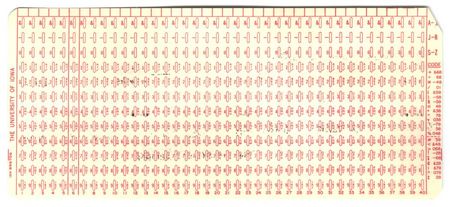For many years, I've told people about how I first learned how to write computer programs by writing on Hollerith Cards with a pencil, but nobody ever believes me. But now, thanks to some research by local computer historian Douglas Jones, I have proof. This card was known as a "Mark Sense" card, you would fill in the little rectangles with a #2 pencil, and the optical card reader would sense the marks.

Sometime around 1968, my math teacher got a grant for some computer time on the University of Iowa mainframes and decided to teach a few of us how write simple FORTRAN programs. In those primitive times, computers used Hollerith cards for input, but obviously it was impractical for little kids to use keypunch machines. So we used Mark Sense cards, painstakingly filling out the little cards with a #2 pencil. It was quite difficult to use the cards accurately, we would often spend as much time correcting input errors in the cards as debugging the programs. It was incredibly frustrating to write a whole program correctly, and then receive no output because you filled in one wrong spot and wrote "PRINL" instead of "PRINT."

Sometime around 1968, my math teacher got a grant for some computer time on the University of Iowa mainframes and decided to teach a few of us how write simple FORTRAN programs. In those primitive times, computers used Hollerith cards for input, but obviously it was impractical for little kids to use keypunch machines. So we used Mark Sense cards, painstakingly filling out the little cards with a #2 pencil. It was quite difficult to use the cards accurately, we would often spend as much time correcting input errors in the cards as debugging the programs. It was incredibly frustrating to write a whole program correctly, and then receive no output because you filled in one wrong spot and wrote "PRINL" instead of "PRINT."
Odd nature of things that I'm older than you but still missed the entire punchcard era of computing.
Wow!
In the early/mid 70's we used these in LA. (Junior high school, though my sister used them in elementary school I think.) They'd pick up a mail-bag of cards, and come back a couple of days later with printouts. Yes yes yes! The system was called "M. I. S. S.", and I can't remember what that stood for.
The long turnaround time built character.
Thanks for the remembrance.
I used these also in the Los Angeles school system. M.I.S.S.
stood for Mathematics Instruction Support System.
Thanks for maintaining this page.
I used these in LA from 76 to 78, and then one day I discovered the FORTRAN punch command and would write programs to punch a few cards with random data, punch a few blank cards. Punch a few cards with random data, punch a few blank cards.
And then thank god, I'd take the blank cards over to CSUN and use their KP-29.
[I remember when I discovered our IBM/360 could punch cards. I maintained a mailing list on punched cards for our high school newspaper. So I decided to make a backup deck, which was a good idea because someone dropped the master copy outdoors and it was ruined. I remember the punched cards had no characters at the top, so you couldn't read them. So you had to put them through the UNIVAC "Card Interpreter" which did nothing but read each card and print the card's contents at the top. It used an incredibly fast daisy wheel printer, which made an awesome buzzing noise. --Charles]